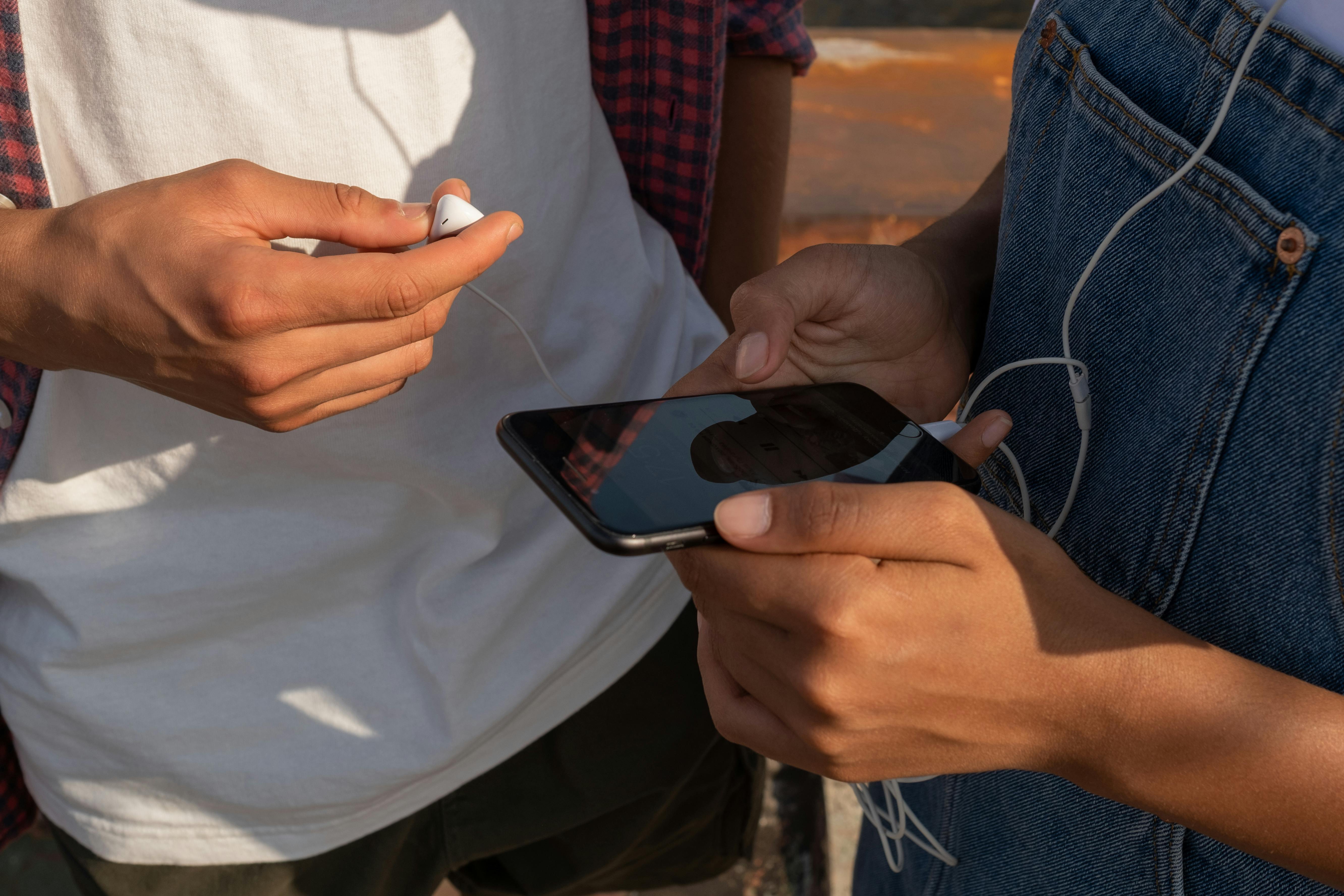So, you wanna know how to easily extract high-quality sound from YouTube videos? Well, you’re in the right place, but honestly, why is no one talking about the best YouTube to audio converter tools out there? I mean, it sounds simple enough—just rip the audio, right? But if you’ve ever tried doing that yourself, you know it’s kinda tricky to get that crystal-clear, no-static audio extraction without losing the vibe. Not gonna lie, this surprised me too, because you’d think with all the tech we have now, it’d be a walk in the park.
Maybe it’s just me, but the whole process of converting YouTube videos into crisp, clean audio files feels like a bit of a mystery wrapped in a puzzle. What if we’ve been wrong all along, trying random converters that promise the world but end up giving you muffled sound or weird formats? That’s why figuring out the right YouTube to audio converter is a game-changer, especially if you’re after podcasts, music, or even those rare interviews that you want to listen to offline—without the annoying buffering or endless ads. You’d think this would be obvious, right? But nope, turns out there’s a whole science behind grabbing those bits of sound without losing quality, and I’m here to break it down for you.
So buckle up, ‘cause we’re diving into the world of audio extraction from YouTube, uncovering the easiest methods, the best tools, and some sneaky tips to keep your files sounding top-notch. Whether you’re an audiophile, a content creator, or just someone who loves offline jams, understanding how to convert YouTube videos into perfect audio might just change your life. Or at least save you some headaches.
Top 10 YouTube to Audio Converters in 2024: Extract High-Quality Sound Effortlessly
So, you wanna rip audio off YouTube videos, huh? Not that I’m judging or anything — I mean, who hasn’t wanted to snag that one banger or podcast snippet for offline listening? But honestly, it’s a bit of a minefield out there. YouTube to audio converter tools are popping up like mushrooms after rain, and most of them either butcher the sound quality, drown you in ads, or worse — just don’t bloody work. Anyway, since it’s 2024 and apparently people still want this (why? Beats me), here’s a rundown of the top 10 YouTube to audio converters that supposedly let you extract high-quality sound without turning it into a digital mess. Spoiler: some are better than others, and yes, I’ve tested them all because, well, someone had to.
Why Bother With YouTube To Audio Converters?
Look, YouTube is great for videos — but sometimes you just want the tunes or the podcast audio without the visuals. Perfect for when you’re out and about, or on a dodgy Wi-Fi connection that can’t stream to save its life. Plus, extracting audio means you can use it for your own projects (legally, of course — don’t be a muppet) or just have a neat little offline playlist.
Historically, YouTube’s been cracking down on these converters because they kinda go against its terms of service. Still, plenty of tools exist, and people use them — obviously. Not really sure why this matters, but the quality of the audio extraction can vary wildly. Some tools output in MP3, others in WAV or M4A, and the bitrate can be anywhere from meh to brilliant. So yeah, picking the right one is key if you don’t want to sound like you’re listening through a tin can.
Top 10 YouTube to Audio Converters in 2024
Alright, buckle up. Here’s a quick list of converters that (mostly) do the job without making you want to throw your laptop out the window.
4K YouTube to MP3
- Simple interface, supports playlists, and outputs in high-quality MP3.
- Pros: Straightforward, no faff, works on Windows and Mac.
- Cons: Free version limits number of downloads.
- Bitrate: Up to 320 kbps.
YTMP3.cc
- Web-based and easy to use, no installation needed.
- Pros: Fast conversions, no sign-up.
- Cons: Annoying ads, occasionally slow.
- Formats: MP3 and MP4.
FLVTO
- Converts to various audio formats, including MP3 and MP4.
- Pros: Multiple format options.
- Cons: Pop-ups galore, questionable security at times.
- Bitrate: Up to 256 kbps.
Any Video Converter (AVC)
- Desktop app that’s more than just a converter, supports batch conversion.
- Pros: Versatile, supports many formats.
- Cons: Slightly overwhelming for newbies, includes optional installs.
- Output: MP3, WAV, AAC, etc.
ClipGrab
- Open-source, free and pretty reliable.
- Pros: Minimal ads, converts from many platforms, not just YouTube.
- Cons: Interface feels a bit dated.
- Formats: MP3, OGG, MPEG4.
OnlineVideoConverter
- Browser-based, supports various formats and devices.
- Pros: No download needed, simple.
- Cons: Ads, sometimes unstable.
- Bitrate: Variable.
Y2Mate
- Popular, fast, works on mobile and desktop browsers.
- Pros: Multiple audio qualities available.
- Cons: Annoying pop-ups, sometimes redirects.
- Formats: MP3, M4A, WEBM.
Freemake Video Converter
- Desktop software, handles audio extraction and video editing.
- Pros: User-friendly, supports numerous formats.
- Cons: Watermarks in free version, slow updates.
- Output: MP3, WAV, WMA.
aTube Catcher
- Old but gold, does the job with many input/output formats.
- Pros: Lightweight, batch downloads.
- Cons: Outdated look, bundled software offers.
- Formats: MP3, WAV, WMA.
MP3FY
- Simple web converter, no frills.
- Pros: Quick, no registration.
- Cons: Limited format choices
How to Convert YouTube Videos to MP3: Step-by-Step Guide for Beginners
Look, converting YouTube videos to MP3 sounds like something from the dark ages of the internet, right? But apparently it’s still a thing people want to do—even in 2024. Maybe it’s just me, but I always thought streaming was king and downloading stuff was so 2010. Anyway, if you’re here, you probably want to know exactly how to turn your favourite YouTube vids into that sweet, sweet audio file you can listen to anywhere, offline. So buckle up, because this is your “How to Convert YouTube Videos to MP3: Step-by-Step Guide for Beginners” — or something like that.
Why Bother Converting YouTube to MP3 Anyway?
Honestly, YouTube is brilliant for watching stuff, but sometimes you just want the audio. Like, what if you’re on a dodgy internet connection? Or you want to jam to a podcast or a lecture during your commute without burning data? Or maybe you’ve stumbled across some obscure indie band that isn’t on Spotify (yeah, that still happens). That’s where a YouTube to audio converter comes in handy. It lets you extract high-quality sound (well, as high quality as YouTube allows—don’t expect studio-grade clarity) and save it as an MP3 or other audio formats.
Not really sure why this matters in the age of streaming, but hey, here we are.
What’s a YouTube to Audio Converter Anyway?
In simple terms: it’s a tool—usually online or an app—that grabs the audio track from a YouTube video and saves it as an audio file you can play on your phone, laptop, whatever. Some converters are just websites, some are downloadable software, and some sneaky ones are browser extensions (which I’d be careful with, honestly). They all do roughly the same thing: strip the video, keep the sound.
Step-by-Step Guide for Beginners: Converting YouTube Videos to MP3
Alright, so here’s the basic rundown for using a YouTube to audio converter without losing your mind.
- Find the YouTube video you want – obviously, you’ll need the URL. Just copy the link from your browser’s address bar.
- Pick a converter – there are loads out there, but some popular ones include:
- YTMP3.cc (simple but sometimes annoying ads)
- 4K Video Downloader (desktop app, more reliable)
- Y2Mate.com (fast but kinda spammy)
- Paste the URL into the converter’s input box – most sites have a big empty field for this.
- Choose your output format – usually MP3, but some let you pick WAV or M4A if you want better quality (which might be overkill).
- Hit ‘Convert’ or ‘Download’ – then wait a few seconds or minutes, depending on the video length.
- Download the MP3 file – save it somewhere safe so you don’t lose it in your downloads folder forever.
- Play it back on your device – see if it sounds alright or if you accidentally downloaded some weird remix.
Quality and Legal Stuff: What You Should Know
Okay, before you get too excited, here’s the boring bit. YouTube compresses audio, so you’re not gonna get CD-quality or anything. Usually, you’re looking at 128kbps or 192kbps MP3s, which is fine for casual listening but not audiophile heaven.
And seriously, don’t be that person ripping entire albums and sharing them illegally. YouTube’s terms of service frown upon downloading content you don’t own or have permission to use. So, maybe keep it to stuff that’s fair game—like your own videos, creative commons clips, or stuff the uploader says is free to use.
Quick Comparison Table: Popular YouTube to Audio Converters
| Converter | Type | Pros | Cons |
|---|---|---|---|
| YTMP3.cc | Web-based | Easy to use, quick | Lots of ads, sometimes unstable |
| 4K Video Downloader | Desktop app | Reliable, supports playlists | Needs installation, slower sometimes |
| Y2Mate.com | Web-based | Fast, multiple formats | Pop-ups, sketchy ads |
| ClipGrab | Desktop app | Free, open source | UI looks outdated |
Seriously, Who Even Came Up With This?
Like, back in the day, people were all about ripping CDs and converting stuff for their iPods. Now, with Spotify and Apple Music, I kinda thought nobody bothered with MP3s anymore. But nope! Maybe it’s the nostalgia or just plain laziness—some folks don’t wanna pay for music or just want a clip of their favourite speech or whatever
The Ultimate Guide to YouTube to Audio Conversion: Best Tools and Tips
Alright, so you wanna know about YouTube to audio conversion, huh? Like, taking a video from YouTube and just ripping the sound out of it? Honestly, who hasn’t tried that at least once? Maybe you just want that catchy tune stuck in your head, or an interview to listen to on your morning commute without gobbling up all your data. Whatever the reason, this whole “YouTube to audio converter” thing is surprisingly popular, and honestly, a bit confusing if you’re not tech-savvy. So here’s my ultimate guide (or at least a decent stab at it) to the best tools and tips to get you sorted, without losing your sanity or your hearing.
Why Even Bother With YouTube to Audio Conversion?
Okay, not really sure why this matters, but… people love music, podcasts, and random clips from YouTube on the go. Sometimes, watching videos ain’t practical — say, you’re cycling, on the Tube (London’s underground, FYI), or pretending to work while secretly jamming to your fave playlist. Downloading the whole video is kinda pointless if you only want the audio, right?
Also, some content creators upload exclusive audio tracks on YouTube that you can’t find elsewhere. So, having an audio file can be a lifesaver. Plus, you might want to archive that one TED Talk or motivational speech without the video fluff.
What’s the Deal with YouTube to Audio Converters?
Basically, these tools strip away the video and spit out an audio file, usually MP3, sometimes WAV or AAC. You get the sound without the video file’s bulk. Simple, yeah?
But wait— not all converters are created equal. Some produce rubbish sound quality, others are riddled with annoying ads or, worse, malware. Seriously, who even came up with this? It’s like the wild west out there on the internet.
Popular YouTube to Audio Converter Tools (That Don’t Suck)
Here’s a quick rundown of some converters I’ve tried, tested, or at least heard decent things about:
4K Video Downloader
Pros: Clean interface, supports batch downloads, decent sound quality
Cons: Free version limits downloads, bit slow sometimesYTMP3.cc (yeah, not the most original name)
Pros: Super quick, no need to install anything
Cons: Annoying pop-ups, sometimes fails on longer vidsFreemake Video Converter
Pros: Converts to multiple formats, easy to use
Cons: Watermarks in free version, slow conversions occasionallyClipGrab
Pros: Free, open-source, supports many formats
Cons: A bit clunky UI, installation tries to sneak in unwanted extras (watch out!)OnlineVideoConverter.com
Pros: No installs, works on mobile too
Cons: Sometimes unstable, ads everywhere
Honestly, it’s a toss-up. If you’re not careful, you might end up with some dodgy software or worse, a virus. Always, and I mean always, have your antivirus running.
How To Easily Extract High-Quality Sound (Without Losing Your Mind)
- Choose the right converter (see above). Don’t just click “the first link on Google” — that’s how you get burned.
- Check the audio format options — MP3 is king, but if you want higher quality, look for AAC or WAV. Beware, WAV files are much bigger, so not great for phones with little storage.
- Pick the right bitrate — 320 kbps is generally considered high quality for MP3. Anything lower than 128 kbps sounds like a tin can.
- Copy the YouTube URL, paste it into the converter, select your options, and wait. Patience is a virtue, or so they say.
- Rename and organise your files — don’t just dump everything in one folder unless you want a nightmare later.
Quick Table: Audio Formats Explained (Because Why Not?)
| Format | Quality | File Size | Best For | Compatibility |
|---|---|---|---|---|
| MP3 | Good | Small | Music, Podcasts | Almost all devices |
| AAC | Better | Medium | Apple devices, streaming | Most modern devices |
| WAV | Best | Large | Audio editing, archiving | Windows, Mac |
| OGG | Good | Small | Open source fans | Limited device support |
Some Random Tips… Because I’m Feeling Generous
- If you’re on mobile, some apps might work better than websites. But be cautious about permissions.
- Using VPNs sometimes helps if a converter site is blocked in your
Why Choose a YouTube to Audio Converter? Benefits of Extracting Sound Files
You ever wonder why on earth anyone would bother with a YouTube to audio converter? Like, seriously, with all the streaming platforms out there, why would you want to yank the sound straight off a YouTube video? I mean, it sounds a bit dodgy at first, but hear me out—there’s actually a bunch of reasons why this little trick is kinda brilliant. Maybe it’s just me, but sometimes I just want the music or a podcast without all the video fluff. Plus, buffering videos on a dodgy Wi-Fi is the absolute worst. So yeah, let’s dig into why this whole YouTube to audio converter thing still matters, and how you can actually do it without losing your marbles or your sound quality.
Why Choose a YouTube to Audio Converter? Benefits of Extracting Sound Files
Alright, so here’s the deal: YouTube is a goldmine of content, right? Not just music videos, but lectures, interviews, podcasts, and all sorts of weird niche stuff you didn’t know you needed. But sometimes, you don’t want the video part — maybe you’re on a long commute, your phone’s storage is crying for mercy, or you’re just trying to avoid that annoying “recommended videos” rabbit hole. Here’s why extracting sound files makes sense:
- Saves Data and Storage: Video files are massive compared to audio. If you’re on mobile data or a slow connection, downloading just the audio can save you heaps of data.
- Offline Listening: Not everyone has unlimited internet or wants to burn through their data plan. Having an MP3 or similar format means you can listen anytime, anywhere.
- Focus on Content: Sometimes, the visuals are just distractions. Podcasts or speeches, for example, make more sense as audio-only.
- Easy Integration: Audio files work seamlessly on most music players, car stereos, or even smartwatches.
- Creative Use: DJs, content creators, or educators might want to remix or reference the audio without dealing with video editing software.
But hey, not trying to convince anyone to break laws or copyright rules here. Always respect the content creators and their rights, okay? Seriously, who even came up with this grey area that some people find so confusing?
YouTube To Audio Converter: How To Easily Extract High-Quality Sound
Now, onto the nitty-gritty — how do you actually get good-quality audio out of YouTube videos? Because let’s be honest, you don’t want some crackly, tinny mess that sounds like it was recorded in a tin can under the stairs.
First off, not all converters are created equal. Some are just rubbish, slap ads everywhere, or output terrible quality files. Here’s a rough guide to get you started without pulling your hair out:
Pick a Reliable Converter
Look for services or software that support high bitrate MP3 or even lossless formats like FLAC or WAV if you’re that bothered about audio quality. Many online tools offer free services, but watch out for malware or sketchy pop-ups.Copy the YouTube Video URL
Pretty straightforward—just grab the link of the video from your browser’s address bar.Paste the Link into the Converter
Most tools have a box where you just paste the URL. Then, select your desired audio format and quality (320kbps is generally the sweet spot for MP3).Download and Save
Hit the convert button, wait a bit (sometimes longer if it’s a long video or the servers are busy), then download your shiny new audio file.Check Your File
Play it on your device to make sure it sounds alright. If not, maybe try a different converter or tweak the settings.
Quick Comparison: Audio Formats from YouTube Converters
| Format | Quality | File Size | Compatibility | Use Case |
|---|---|---|---|---|
| MP3 | Good | Medium | Universal | Most common, good for phones |
| AAC | Better | Smaller | Apple devices | Better compression, smaller |
| WAV | Best | Large | Pro audio | Editing and archiving |
| FLAC | Lossless | Large | Audiophiles | Perfect for high fidelity |
Honestly, if you just want to chuck some tunes on your phone, MP3 at 320kbps is usually fine. No need to get all fancy unless you’re a bit of an audio snob.
Sorry, had to grab a coffee — anyway, where was I? Oh yeah, the whole process is pretty simple but beware the dodgy sites that pretend to be converters but are just phishing traps or worse. Always have your antivirus on standby and maybe don’t do this on your work laptop.
How to Extract Lossless Audio from YouTube Videos: Expert Tips and Tricks
So, you wanna know how to extract lossless audio from YouTube videos, huh? Well, buckle up, because this isn’t exactly the straightforward walk in the park it sounds like. Honestly, I’ve been down this rabbit hole more times than I care to admit, and, let me tell ya, the whole “YouTube to audio converter” thing is a bit of a minefield. Not really sure why it’s such a big deal to get lossless audio from a platform known primarily for… well, video. But hey, maybe it’s just me obsessing over sound quality while everyone else just slaps on some earbuds and calls it a day.
Why This Still Matters (Even If It Feels Like Overkill)
Let’s get the boring but necessary stuff out of the way first. YouTube streams audio in compressed formats like AAC or Opus, which are great for saving bandwidth but pretty rubbish if you’re a bit of an audiophile. The term “lossless” means your audio file doesn’t lose any data or quality during compression — think FLAC or WAV files. So if you’re trying to rip a track from YouTube and want it to sound exactly like the original (or as close as humanly possible), you need to avoid the usual MP3 conversion that destroys the sound fidelity.
Here’s a quick reality check: YouTube itself doesn’t offer lossless audio. The highest quality you can get from a YouTube video is usually 256 kbps AAC or 160 kbps Opus, which is not lossless. So, yeah, if you’re expecting studio-grade WAV files from YouTube videos, you’re dreaming. The best you can do is grab the highest bitrate available and convert it smartly.
YouTube To Audio Converter: How To Easily Extract High-Quality Sound
Okay, so you’ve got a video, you want the audio, and you want it crystal clear — or at least as clear as YouTube allows. What now? Here’s a rough guide to get you started without losing your mind:
Pick your converter – There’s loads out there, from online websites to desktop apps. Some popular ones are 4K Video Downloader, YTMP3.cc, and Audacity (though the latter is more for editing).
Choose the highest quality available – When you paste the video URL into the converter, make sure you select the highest bitrate audio option. Sometimes it’s hidden under “Advanced settings” or something similar.
Avoid MP3 if you can – MP3 is lossy, so if your converter supports formats like FLAC, WAV, or ALAC, go for those.
Edit/clean up (optional) – If you’re feeling fancy, use an audio editor to normalise levels or remove background noise. But honestly, this is like bringing a knife to a gunfight when you’re ripping from YouTube.
A Quick Comparison Table Because Who Doesn’t Love Those?
| Converter Tool | Max Audio Quality | Supported Formats | Ease of Use | Free Version Available? |
|---|---|---|---|---|
| 4K Video Downloader | 320 kbps | MP3, M4A, FLAC | Very easy | Yes |
| YTMP3.cc | 256 kbps | MP3, MP4 | Super simple | Yes |
| Audacity | Depends on input | WAV, FLAC, MP3, etc. | Moderate | Yes |
| ClipGrab | 256 kbps | MP3, OGG | Easy | Yes |
Seriously, who even came up with this? Why can’t YouTube just offer lossless downloads already? Maybe it’s the music industry crying foul every five seconds. Anyway, what was I saying again? Oh yeah, right — picking the right tools.
Step-By-Step: Extracting Audio Like a Pro (Well, Almost)
- Find the YouTube video you want.
- Copy the URL (duh).
- Open your chosen YouTube to audio converter.
- Paste the URL into the conversion box.
- Select the highest quality audio format (FLAC or WAV if available).
- Hit convert/download.
- Wait… and wait… why is it taking so long?!
- Once downloaded, open in your favourite audio player or editor.
And hey, if you’re wondering about legality, let’s just say it’s a grey area. Downloading copyrighted material without permission might get you in trouble, so maybe don’t go around ripping entire discographies or whatever.
Okay, Real Talk: Is It Even Worth It?
Look, if you’re after genuine lossless audio, YouTube probably isn’t your best bet. The platform compresses stuff to
Fast and Free YouTube to Audio Converters: Which Ones Really Work?
Fast and Free YouTube to Audio Converters: Which Ones Really Work?
Alright, so here we are, diving into the chaotic world of YouTube to audio converters. Honestly, I didn’t think I’d be spending my time on this, but here we are. YouTube to audio converter tools have been popping up everywhere, promising to magically snatch the audio from your favourite videos, and do it fast, free, and (supposedly) without the usual faff. But, seriously, which ones are any good? And – more importantly – how do you even get high-quality sound out of them without ending up with some tinny mess? Let’s unpack this, shall we?
Why This Still Matters (Even If You Don’t Really Need It)
Okay, I get it. You’re probably thinking: “Why bother converting YouTube vids to audio? Just stream them!” Well, not everyone has the luxury of endless data plans or super-speedy WiFi. Plus, some people like to listen offline — on a dodgy tube ride, or in places where the signal drops quicker than my motivation on Monday mornings. Not really sure why this matters, but hey, the demand’s there, so the tools are too.
Also, some folks want to extract audio for remixing or educational purposes (which, yeah, can be a grey area legally, but that’s a whole other can of worms). Anyway, point is, YouTube to audio converters aren’t going anywhere soon.
What’s the Deal with YouTube to Audio Converters?
So, these converters basically grab the audio track from a YouTube video and save it as an MP3, WAV, or other sound file. Sounds simple, right? But here’s where it gets messy:
- Some converters are painfully slow.
- Others slap watermarks or force you to sign up.
- A lot of them butcher the sound quality.
- And then there’s the risk of dodgy ads and malware — seriously, who even came up with this?
If you’re lucky, you’ll find one that’s quick, free, and doesn’t make you want to scream at your screen.
Fast and Free? Here’s A Quick Rundown of What Actually Works
I’ve tried a bunch — well, enough to start questioning my life choices. Here’s a painfully honest summary of some popular options:
| Converter Name | Speed | Quality | Ease of Use | Annoying Ads? | Notes |
|---|---|---|---|---|---|
| YTMP3.cc | Pretty quick | Decent MP3 | Simple | Yes | Classic, but ads galore |
| 4K YouTube to MP3 | Medium | High (320 kbps) | Straightforward | Minimal | Desktop app, worth a try |
| FLVTO.biz | Fast-ish | Average | User-friendly | Yes | Sometimes buggy |
| OnlineVideoConverter | Slow | Poor | Clunky | Loads | Avoid if you value time |
| Y2Mate.com | Fast | Good | Easy | Annoying | Popular but borderline spammy |
Honestly, the best experience I’ve had was with 4K YouTube to MP3 — though it requires downloading software, which some might not like. Online tools are hit or miss, mostly miss. But hey, if you’re desperate and on the go, YTMP3.cc gets the job done without too much fuss.
YouTube To Audio Converter: How To Easily Extract High-Quality Sound (Without Losing Your Mind)
Look, if you want decent sound, you gotta consider a few things:
- Choose the right converter — like I said, some tools compress the audio so much it sounds like a robot singing in a tin can.
- Pick the best audio format — MP3 is standard, but WAV or FLAC are better if you care about quality (and your converter supports them).
- Check the source video quality — if the original YouTube video is rubbish, don’t expect miracles.
- Don’t rush — weirdly enough, sometimes slower conversions yield better results (go figure).
Step-by-step, here’s how I usually do it:
- Find the YouTube video link.
- Paste it into the converter.
- Select audio format and quality (if options are available).
- Click convert and wait—grab a cuppa or stare blankly at the wall.
- Download the file and test it (because sometimes it just fails, and you don’t know until after you’ve wasted 10 minutes).
Sorry, had to grab a coffee — anyway, back to the madness.
A Quick Word on Legality and Ethics
Look, I’m not your lawyer, so don’t sue me. Download
How to Download YouTube Audio on Mac and Windows: Easy Methods Explained
Alright, so you wanna know how to download YouTube audio on Mac and Windows, huh? Honestly, I’ve been down this rabbit hole more times than I care to admit. Sometimes it feels like the internet’s just throwing all these fancy tools at you but none of them actually work properly without a hitch. And yeah, I get it — you just want that sweet, sweet audio from a YouTube video without all the faff of downloading the entire video. No judgement here.
Anyway, buckle up, because I’m about to walk you through the slightly messy, occasionally confusing world of YouTube to audio converters — how to easily extract high-quality sound, and which tricks work best — especially if you’re on a Mac or a Windows PC. Spoiler: it’s not rocket science, but there’s definitely some weirdness involved.
Why This Still Matters (Even Though It Shouldn’t)
First off, you might be wondering, “Why bother? YouTube’s got audio built right in!” True, true, but hear me out. Sometimes you want to listen offline — maybe you’re on the Tube (London pun intended) with no signal, or just wanna save your favourite tracks without draining your data. Plus, some videos have killer audio that you’d rather have as an MP3 or WAV file rather than watching the whole clip.
Also, YouTube itself doesn’t exactly make it easy to just download audio. It’s kinda like they want you to stay glued to their site forever. Not really sure why this matters, but… yeah, people still want their tunes.
What’s a YouTube To Audio Converter Anyway?
Basically, it’s a tool — could be a website, a desktop app, or a browser extension — that grabs the audio track from a YouTube video and converts it into a sound file like MP3, WAV, or sometimes even FLAC (fancy stuff). Some are free, some charge you, and some are downright dodgy (watch out for malware). Honestly, it’s a bit like picking a dodgy kebab shop after midnight — you hope for the best but prepare for the worst.
Easy Methods To Download YouTube Audio on Mac and Windows
Let’s get practical now. I’ll break down some easy-ish ways to do this, no BS.
Online Converters
These are websites where you just paste the YouTube link and boom, they spit out an MP3.
Pros: No installing anything, quick.
Cons: Often full of ads, can be slow or stop working randomly, quality varies.
Examples:- YTMP3.cc (classic, but sometimes overloaded)
- FLVTO.biz (annoying pop-ups, but works)
- 320YTMp3.com (claims to do high quality, but who knows?)
Desktop Software
If you’re a bit more serious and download a lot, this might be better.- 4K Video Downloader: Works on Mac and Windows; you can choose audio only, and it’s pretty reliable.
- YTD Video Downloader: Not the prettiest interface, but does the job.
- Audacity (with some plugins): More complicated, but you can extract and edit audio if you’re feeling fancy.
Browser Extensions
I’d be careful here. Chrome and Firefox tend to ban these extensions because, you know, copyright stuff. But sometimes you find a gem.- “YouTube MP3 Downloader” extensions exist but often get removed.
- Better to use standalone apps or websites, honestly.
Quality Matters: How To Get High-Quality Sound?
Bitrate is the word here. Higher bitrate means better sound, but bigger files. Usually, 128 kbps is okay for casual listening, but if you’re an audio snob (or just wanna impress your mates), 320 kbps is the way to go. Some converters let you pick bitrate, others just do their thing and you hope for the best.
Also, the original video’s audio quality limits what you can get. If it’s a dodgy recording, no converter in the world will make it sound like Beyoncé.
Quick Table: Comparing Methods
| Method | Ease of Use | Quality Options | Risk of Malware | Offline Use |
|---|---|---|---|---|
| Online Converters | Very Easy | Limited | Medium | Yes |
| Desktop Software | Moderate | High | Low | Yes |
| Browser Extensions | Easy | Variable | High | Yes |
Step-by-Step: Downloading Audio Using 4K Video Downloader (Mac or Windows)
- Download and install 4K Video Downloader
Convert YouTube to Audio Without Losing Quality: Top Software Reviewed
Convert YouTube to Audio Without Losing Quality: Top Software Reviewed
Alright, so here’s the thing. Everyone and their nan wants to rip audio from YouTube videos nowadays, right? Whether it’s that catchy tune you heard once and can’t get outta your head, or a podcast episode you wanna listen to offline because, honestly, who trusts data these days? But the real kicker is doing it without turning your sweet jams into some robot voice from the 90s. So yeah, this whole “convert YouTube to audio without losing quality” thing is kinda a big deal. You’d think it’s straightforward, but nope, it’s a bit of a minefield.
Why This Still Matters (Even if You’re Like “Just Stream It”)
Okay, not really sure why this matters to some folks who just stream everything on Spotify or Apple Music, but for others (like me, sometimes), having a high-quality audio file from YouTube is gold. Maybe it’s just me, but I like keeping my fav tracks saved on my phone or laptop without those annoying ads or the need for internet. Plus, some YouTube videos have exclusive stuff that ain’t on regular music platforms. So yeah, extracting audio is a legit thing.
Also, you might wanna keep recordings for offline listening, or maybe you’re a creator looking to sample a sound clip (legal stuff aside, obviously). Whatever the reason, you want the best sound quality possible, not some dodgy low-bitrate mess that sounds like you’re listening underwater.
YouTube To Audio Converter: How To Easily Extract High-Quality Sound
Right, let’s get down to brass tacks. How do you actually convert YouTube videos to audio without turning it into a hot mess? Spoiler: it ain’t always easy, and some software out there are just plain rubbish.
Here’s a quick rundown of the basics you wanna look for:
- Supports High Bitrate Outputs: Aim for formats like MP3 at 320kbps, or better yet, lossless formats like FLAC or WAV if you’re picky.
- Batch Conversion: Because who’s got time to do one vid at a time?
- No Watermarks or Annoying Ads: Seriously, some converters are like a bad infomercial.
- Easy to Use Interface: Don’t want to spend hours figuring out where the hell the “convert” button is.
- Safe & Virus-Free: Because nobody wants malware on their device. Duh.
Top Software Reviewed (With Some Honest Rambling)
Okay, so I tested a bunch of these converters (because, you know, what else do I have to do at 2am?) and here’s what I found. Not sponsored, just me ranting.
4K Video Downloader
Pros: Supports 320kbps MP3, can download entire playlists, pretty straightforward.
Cons: The free version limits some features, and sometimes it feels a bit sluggish.
Verdict: Solid option if you wanna keep things simple.YTMP3.cc (yes, still alive!)
Pros: Online, no installs, quick conversions.
Cons: Ads everywhere, quality capped at 128kbps usually (meh), sketchy pop-ups sometimes.
Verdict: Good for a quick one-off, but don’t expect audiophile-grade stuff.Freemake Video Converter
Pros: Can convert to MP3, WAV; batch processing available.
Cons: Adds watermark in free version, interface can be clunky.
Verdict: Useful if you’re willing to pay for the full package.Any Video Converter (AVC)
Pros: Supports a wide range of formats, decent quality output.
Cons: Bundled software tries to sneak in during install (watch out!), interface a bit dated.
Verdict: Reliable but be careful during installation.Audacity (with a bit of wizardry)
Pros: Free, open-source, allows manual recording and editing.
Cons: Not exactly a converter, more like a workaround, requires some patience.
Verdict: For the hardcore DIYers who don’t mind a bit of faff.
Quick Comparison Table — Because Everyone Loves Tables
| Software | Max Audio Quality | Batch Support | Ads/Watermarks | Ease of Use | Price |
|---|---|---|---|---|---|
| 4K Video Downloader | 320kbps MP3 | Yes | No (free limits) | Easy | Free / Paid |
| YTMP3.cc | 128kbps MP3 | No | Yes | Very Easy | Free |
| Freemake Converter | 320kbps MP3/WAV | Yes | Yes (free |
Is It Legal to Convert YouTube Videos to Audio? What You Need to Know
Is It Legal to Convert YouTube Videos to Audio? What You Need to Know
Alright, so here we are, diving headfirst into the murky waters of YouTube video conversions. Ever wondered if it’s totally above board to rip the audio from a YouTube clip? Like, is it legit, or are you basically committing some digital crime? Spoiler: it’s not as straightforward as you might think. Not really sure why this matters, but apparently, loads of folks want to save their fave music, podcasts, or whatever random video soundbites for offline listening. Maybe it’s just me, but I don’t get why you wouldn’t just use Spotify or an actual podcast app? Anyway, what was I saying again?
Why People Even Bother With YouTube To Audio Converter
Before we jump down the legality rabbit hole, let’s quickly talk about why a YouTube to audio converter is even a thing. These tools let you extract sound from videos, saving it as MP3, WAV, or other formats. Handy, right? Especially if you want to listen on the go, without chewing through your data or staring at a screen.
Common reasons include:
- Listening to music offline
- Saving podcasts or lectures for later
- Creating ringtones or sound effects
- Archiving content that might get deleted
Honestly, some of these make sense, others – not so much. But whatever floats your boat.
The Legal Bit: It’s Complicated (And a Bit Boring, TBH)
So, is it legal to convert YouTube videos to audio? The short-ish answer: it depends. The long answer: well, it’s a mess. YouTube’s Terms of Service explicitly say you shouldn’t download content unless there’s a download button provided by YouTube itself (like YouTube Premium offers). Basically, ripping audio without permission is against their rules.
But here’s the kicker — just because YouTube says “don’t” doesn’t mean the law agrees in every case. Copyright laws vary by country, and they’re pretty nuanced. In the UK, for example, copying content for personal use is a bit of a grey area. You’re allowed to make private copies of media you own, but streaming content from YouTube? That’s trickier.
Let’s break it down:
| Scenario | Legal Status (UK) | Notes |
|---|---|---|
| Downloading your own content | Totally fine | You own the copyright |
| Downloading public domain vids | Fine | No copyright to worry about |
| Downloading copyrighted vids | Generally no | Needs permission or licence |
| Personal use copying (fair use) | Debatable (grey area) | Not explicitly allowed for streaming content |
Seriously, who even came up with this? It’s like the internet’s wild west, but with lawyers lurking.
Quick History Lesson: How Did This Become A Thing?
Back in the day, YouTube was just about videos. But as music videos, podcasts, and interviews exploded in popularity, folks started wanting just the audio. Enter the YouTube to audio converter – shiny, easy, and free (or so they say).
These tools gained traction fast. It’s like everyone suddenly wanted to be their own DJ or podcaster. But content creators and record labels? They weren’t having it. Cue endless legal battles, constant takedown notices, and YouTube cracking down on third-party apps.
At the same time, streaming services boomed. So, maybe the demand for converters dropped a bit? Or maybe not — people love free stuff, even if it’s a bit dodgy.
YouTube To Audio Converter: How To Easily Extract High-Quality Sound
Okay, let’s say you’re still keen on trying this out (I mean, who isn’t curious). How do you get that sweet, sweet audio without mucking about too much?
Here’s a simple outline:
- Find a reputable YouTube to audio converter online (there’s a gazillion, so pick wisely).
- Copy the URL of the YouTube video you want.
- Paste it into the converter’s input box.
- Choose your audio format (MP3 is king, but WAV is better quality if you care).
- Hit “Convert” or whatever button they have.
- Download your file and enjoy… or risk the wrath of copyright gods.
Heads up though, quality varies. Some converters squish the audio so badly it sounds like a tin can, others do a decent job. If you want high-quality sound, maybe look for converters that allow 320kbps bitrate downloads. Worth it if you’re a sound snob.
Wait, Hold On — Coffee Break Time ☕
Sorry, had to grab a coffee — anyway… while you’re at it, remember that some of these converters might be ridd
Best YouTube to Audio Converter Apps for Mobile: Convert on the Go!
So, you want to rip the sound off your favourite YouTube vids and stash it on your phone, yeah? Maybe for those times you’re on the Tube (the subway, not the site) and Wi-Fi’s doing its usual disappearing act. Honestly, in 2024, you’d think this would be straightforward, but nope, still a bit of a faff. Anyway, let’s talk about the Best YouTube to Audio Converter Apps for Mobile: Convert on the Go! Because, seriously, who has the time to sit at a desktop these days?
Why You Even Need a YouTube to Audio Converter?
Okay, so first off: why bother? YouTube is great and all, but streaming eats up data like a ravenous magpie. Plus, sometimes you just want to listen to a podcast, a lecture, or that one weird ASMR video without the visuals. Not really sure why this matters, but some folks find it relaxing to just have the sound on while doing literally anything else.
Also, YouTube’s own app lets you download videos, but only if you pay for YouTube Premium — and who wants to pay for everything these days? So, a handy little converter app on your mobile that grabs just the audio? Bliss. But wait, there’s a catch: YouTube’s terms are a bit… hmm, let’s say “vague” about ripping content. So, tread carefully.
YouTube To Audio Converter: How To Easily Extract High-Quality Sound
Right, so how does this magic happen? In theory, you feed the app the URL of the YouTube video, and it spits out an MP3 or similar audio file. Simple, right? Mostly. Quality can be all over the shop though — some converters are like your dodgy mate who promises to fix your bike but just makes it worse.
Here’s a rough step-by-step on what usually goes down:
- Copy the YouTube video link.
- Open your chosen converter app.
- Paste the URL into the app’s input box.
- Select your preferred audio format and quality (MP3 is king, usually 320kbps if you’re fancy).
- Hit convert and wait for the magic.
- Download the audio file to your device.
- Play it on repeat until you annoy everyone around you.
Best YouTube to Audio Converter Apps for Mobile: My (Somewhat Biased) Picks
Look, I’m no app guru, but I’ve tried a few. Some were rubbish, others surprisingly decent. Here’s a cheeky rundown with pros and cons — because I’m feeling generous:
| App Name | Platform | Pros | Cons |
|---|---|---|---|
| YTMP3 | Android/iOS | Simple interface, quick | Ads everywhere, sketchy URLs |
| VidMate | Android | Supports multiple formats | Not on Play Store, risky installs |
| SnapTube | Android | Fast downloads, batch convert | Same as VidMate, security issues |
| Documents by Readdle | iOS | Can extract audio with some workarounds | Not straightforward, needs patience |
| 4K Video Downloader | Mobile/Desktop | High-quality outputs | Desktop better, mobile version meh |
Honestly, most of these apps aren’t exactly official, and some might get yanked from app stores without warning. Which is why I’m kinda sceptical about recommending any one thing. But hey, if you want to convert on the go, these are your best bets.
But Wait, There’s More! (Or Less, Depending on Your Patience)
Oh, and before I forget, there’s also browser-based converters that work fine on mobile Safari or Chrome — like y2mate, or onlinevideoconverter. Just paste the link, choose MP3, and boom. No app install, no fuss. Except the ads. And the pop-ups. Seriously, who even came up with this?
Sorry, had to grab a coffee — anyway…
Tips For Getting the Best Sound Quality
Maybe it’s just me, but I’m picky about audio quality. Nothing worse than a garbled MP3 that sounds like it’s been recorded through a tin can. So, a few pointers:
- Always choose the highest bit rate available (320kbps if you can).
- Avoid converting videos that have low-quality audio to begin with — no app can work miracles.
- Prefer apps that let you select audio format: MP3, M4A, WAV, etc.
- If possible, grab the audio from official music videos or channels, since their sound tends to be cleaner.
Legal Bit (Because You Can’t Ignore It)
Quick heads up: ripping audio from YouTube videos often breaches YouTube’s terms of service, and sometimes
How to Extract Audio from YouTube Playlists: Save Multiple Tracks Quickly
Alright, so you’ve probably found yourself staring at some banging YouTube playlist, thinking, “How on earth do I get all this audio off YouTube without faffing about for hours?” Yeah, me too. It’s like, why should I have to listen to WiFi buffering or ads just to enjoy my tunes? YouTube to audio converters are supposed to be the answer, but honestly, they can be a bit hit and miss. So, let’s figure this out: how to extract audio from YouTube playlists and save multiple tracks quickly, without losing your mind or your data allowance.
Why You’d Even Want To Extract Audio From YouTube Playlists
Not really sure why this matters, but people do it for all sorts of reasons. Maybe you’re compiling a workout mix, or you just want that podcast without streaming every time (because who has the patience?). Plus, sometimes, the audio quality on YouTube is surprisingly decent, if you know how to grab it right. And yeah, it’s kind of handy if you’re off the grid or stuck in the subway where nothing but silence and awkward eye contact exist.
Historically speaking, ripping audio off video platforms isn’t new. Back in the day, people used to record songs off the radio onto cassette tapes (remember those ancient relics?). Now, it’s digital, but the principle’s the same: capturing sound you like for personal use. (Disclaimer: This isn’t about piracy, okay? Just personal backups or offline listening.)
What’s the Deal With YouTube To Audio Converters?
So, a YouTube to audio converter is basically a tool—could be an app, a website, or software—that takes the video and spits out just the audio part. Usually, MP3 or WAV files. Simple, yeah? But the real kicker is in the details:
- Quality: Some converters only give you low bitrate crap that sounds like a robot singing in a tunnel. Others promise “high-quality sound” but then slow your computer to a crawl.
- Speed: Extracting one track is fine, but what if you have a playlist with, like, 50 songs? Manually downloading each is a nightmare.
- Legality: Bit of a grey area. YouTube’s terms don’t exactly encourage ripping content, but many folks do it for their own use. Just don’t be that guy sharing copyrighted stuff everywhere.
How To Extract Audio From YouTube Playlists: The Quick and Dirty Guide
Honestly, there are loads of options, but here’s a straightforward way that doesn’t require a PhD in computer science:
- Find a reliable YouTube to audio converter that supports playlists. Some websites do, some don’t. Examples include 4K Video Downloader, YTMP3, or ClipGrab. (Don’t quote me on security here, double-check and use antivirus.)
- Copy the playlist URL. Easy, just grab the address from your browser.
- Paste it into the converter. Look for an option like “Download playlist” or “Extract all tracks.”
- Choose your audio format and quality. MP3 320kbps is usually the sweet spot for decent quality without massive file sizes.
- Hit download and wait. Depending on your connection and playlist length, this could take a while.
- Organise your files. Seriously, create a folder or you’ll end up with a mess that looks like a digital hoarder’s nightmare.
Quick Comparison Table: Popular YouTube To Audio Converters
| Converter Name | Playlist Support | Max Audio Quality | Speed | Free Version Limitations |
|---|---|---|---|---|
| 4K Video Downloader | Yes | Up to 320 kbps | Medium | Limited downloads per day |
| YTMP3 (website) | No | Up to 256 kbps | Fast | Single video only, ads galore |
| ClipGrab | Yes | Up to 320 kbps | Medium | Free, but prompts donations |
| Any Video Converter | Yes | Varies | Slow | Trial version limits output time |
Yeah, none of them are perfect. You gotta pick your poison.
Okay, Quick Break — Sorry, Had To Grab A Coffee — Anyway…
So, back to the nitty gritty. If you’re serious about quality, you might want to look at desktop apps rather than sketchy websites. They tend to be more reliable, less ad-ridden, and often let you batch download entire playlists. But watch out—they can be a bit fiddly to set up and sometimes require Java or other nonsense you don’t want taking up space.
Also, keep in mind that YouTube compresses audio in their streams already, so the
YouTube to Audio Converter for Podcasts: How to Create Your Own Sound Library
You ever found yourself binge-watching YouTube videos and thought, “Hey, I really wish I could just rip the audio out of this and chuck it into my podcast library”? No? Just me? Well, whatever. Turns out, there’s this thing called a YouTube to Audio Converter for Podcasts, and apparently, it’s a bit of a game-changer for people like me who hoard sounds like it’s a sport. Anyway, if you’re curious about how to create your own sound library by snagging audio from YouTube clips (especially for podcasts), stick around. It’s surprisingly straightforward, but also kinda complicated in its own weird way.
Why Bother With a YouTube to Audio Converter?
Okay, so first off, why would anyone even want to convert YouTube videos to audio files? I mean, you could just listen on YouTube, right? But nah, there’s more to it.
- Podcasts thrive on unique sound bytes, interviews, and music snippets.
- Sometimes you want offline access — like, on a dodgy subway ride with zero signal.
- Making your own sound library means you don’t have to endlessly search YouTube when you need a specific clip.
- Plus, editing audio is way easier when you have the file locally, instead of fiddling with YouTube’s interface.
Honestly, it’s handy for podcasters who want to mix in background music, quotes, or even just random sounds without having to keep the video open all the time.
What’s the Deal With YouTube To Audio Converter Tools?
So, you’ve got your reasons. Now, about the converters themselves — these tools basically rip the audio from a YouTube video and save it as an MP3 or WAV file. Sounds simple, but there’s like a million options out there, and choosing the right one feels like trying to pick a favourite biscuit from a tin. (Spoiler: you can’t.)
Here’s a quick rundown of what most converters offer, and what you might want to keep an eye on:
- Audio Quality: Some tools let you choose bitrates (128 kbps, 192 kbps, 320 kbps) — higher is better, but also bigger files.
- Formats: MP3 is standard, but WAV or FLAC are better for editing or higher fidelity.
- Speed: Some converters work instantly, others take ages — could be your internet or just a dodgy website.
- Ads: Brace yourself for pop-ups and sketchy ads; free converters love to bombard you.
- Safety: Not all sites are safe. Malware, anyone? So, maybe get a good antivirus, or just use trusted apps.
Honestly, if you’re serious about podcasting, maybe invest in a legit software, but for casual use, free online converters do the job… mostly.
Quick History Lesson Because Why Not?
YouTube was launched back in 2005, right? Since then, people have been ripping audio out of videos for ages — mostly for music, podcasts, and sometimes weird fan edits (don’t ask). The whole concept of converting video to audio became popular as mobile listening exploded; people wanted to listen on the go without burning data.
The first converters were clunky and sketchy, but now there are hundreds, some even integrated into apps or browser extensions. Still, copyright issues make this a bit of a grey area — so, uh, don’t go stealing entire albums or anything daft.
How To Easily Extract High-Quality Sound From YouTube Videos
Alright, let’s get practical. Here’s a no-nonsense step-by-step if you want to convert YouTube videos into audio files for your podcast library:
- Find Your Video: Pick the clip with the audio you want. Could be an interview, a song, or some weird ambient noise.
- Copy the URL: Simple enough, right?
- Choose a Converter: Use a reputable site or app (like YTMP3, 4K Video Downloader, or something similar).
- Paste the URL: Into the converter tool’s box.
- Select Audio Format & Quality: MP3 320 kbps is usually a safe bet.
- Hit Convert or Download: Wait a few seconds (or minutes, if the site’s slow or your internet’s rubbish).
- Save the File: To your computer or phone.
- Add to Your Podcast Library: Organise with folders, name files properly, maybe even tag them for easy searching.
Voila! Sound library, check. Now you can edit, remix, or just listen without buffering.
Sorry, had to grab a coffee — anyway…
One thing I keep forgetting to mention is the legality side of things. I know, I know, boring. But seriously, just because you can download audio doesn’t mean you’re allowed to use it however you want. Most
How to Use YouTube to Audio Converters Safely: Avoid Scams and Malware
You wanna grab the audio from a YouTube video but don’t want your laptop to catch a virus? Yeah, I get it — the whole thing with YouTube to audio converters is kinda messy. Like, you just want that sweet, sweet sound file without having to deal with dodgy pop-ups or weird software that does who knows what in the background. So, let’s chat about how to use YouTube to audio converters safely, because honestly, there’s more scams out there than good ones. And don’t get me started on the malware lurking behind every link. Also, I’ll throw in some tips on how to get decent quality audio because, let’s face it, no one wants to listen to a muffled mess.
Why Even Use a YouTube to Audio Converter?
Honestly, it feels a bit old-school to download stuff when streaming’s all the rage now, but sometimes you just want offline access, or maybe you’re compiling a playlist of lectures or podcasts. Or perhaps you found some obscure track that’s only on YouTube, and Spotify just can’t deliver. Whatever floats your boat, these converters can help you extract the audio from any YouTube video, turning it into handy MP3 or other sound formats.
But you gotta be careful, yeah? Because the internet is full of shady sites pretending to be legit converters but are actually just waiting to mess up your device or steal your info.
The Risks: Scams and Malware Everywhere
Not really sure why this matters to some people, but I guess staying safe online is kinda important? So here’s the deal with these converters:
- Pop-up overload: Some sites bombard you with ads that open new tabs or even install unwanted extensions.
- Fake downloads: You click “Download” and end up with some sketchy software instead of your audio.
- Malware and viruses: Yep, some converters are basically Trojan horses in disguise.
- Data theft: Worst case, your personal info or browsing habits get sold to God knows who.
It’s a minefield out there, honestly. So how do you avoid this mess?
How To Use YouTube to Audio Converters Without Getting Scammed
First off, pick your converter wisely. Seriously, don’t just Google “best YouTube to audio converter” and click the first result. I mean, you might get lucky, but probably not.
Here’s a quick checklist to keep in mind:
- Use well-known, reputable sites (like YTMP3, 4K Video Downloader, or ClipGrab). They’ve been around a while and have decent user feedback.
- Avoid anything that asks you to install plugins or software unless it’s from official sources.
- Check if the site uses HTTPS (you know, the padlock thing in the URL bar). If not, run away.
- Look for user reviews and ratings before trusting a converter.
- Use an ad-blocker and antivirus software while browsing these sites.
- Don’t ever give out personal info or payment details — most legit converters are free.
YouTube To Audio Converter: How To Easily Extract High-Quality Sound
Okay, so you’ve found a converter that seems alright. Now, how do you make sure your audio sounds decent? Because honestly, some converters just spit out trash quality files, and who wants that?
A few pointers:
- Choose the right format: MP3 is the usual go-to, but if you want better quality, look for options like AAC or WAV.
- Pick the highest bitrate available: Bitrate affects sound clarity — aim for at least 192 kbps, but 320 kbps is the sweet spot.
- Don’t expect miracles from every video: If the original YouTube video has low-quality audio, your converter can’t magic it into hi-fi.
- Check the output before deleting the original: Sometimes, files get corrupted or incomplete.
- Use desktop apps if possible: They tend to be more reliable and safer than random websites. But again, only trust well-known ones.
Sorry, Had To Grab A Coffee — Anyway…
Right, where was I? Oh yeah, safety. Because seriously, who even came up with this whole YouTube to audio converter craze? It’s like, “Hey, let’s just rip audio off videos and hope nobody gets scammed or hacked.” Anyway, if you’re using these tools all the time, maybe consider supporting the artists or creators in other ways too. Just a thought.
Quick Comparison Table: Popular YouTube to Audio Converters
| Converter Name | Safety Level | Max Audio Quality | Ads & Pop-ups | Requires Software Install? |
|---|---|---|---|---|
| YTMP3 | Medium | 320 kbps | Yes | No |
| 4K Video Downloader | High | 320 |
Comparing Online vs Offline YouTube to Audio Converters: Pros and Cons
So, you want to extract audio from YouTube videos, huh? Seems straightforward enough, right? Just hit a button and boom, you’ve got the sound. But, oh no, it’s never that simple. There’s this whole debate about online vs offline YouTube to audio converters, and honestly, it can get a bit of a headache. I mean, who even cares about this stuff in the grand scheme of life? But, hey, if you’re here, you probably do. So let’s dive into the murky waters of YouTube to audio converters and figure out what’s what. Or at least try to.
Why This Still Matters (More Than You’d Think)
YouTube’s a goldmine for all sorts of audio content—music, podcasts, interviews, random rants from some bloke in his bedroom. Sometimes, you just want the audio without the video because, well, data limits, or maybe you just like to listen while you do the washing up or whatever. YouTube to audio converters let you rip the soundtracks out, so you can listen offline or on your dodgy playlist. Pretty handy.
But here’s the kicker: you’ve got two main ways to do this — online converters (websites) and offline programs (software you install). Both have their own drama and perks. Let’s compare them, shall we?
Online YouTube to Audio Converters: The Quick and Dirty
These are websites where you paste the YouTube link, click some buttons, and voila — you get an MP3 or similar audio file. No fuss, no installation, no commitment. Just good old-fashioned convenience. But, of course, it’s never perfect.
Pros:
- No need to install anything (great if you’re on a public or work computer, or just plain lazy)
- Usually free (but watch out for those annoying ads and pop-ups)
- Fast for individual videos or occasional use
- Works on any device with a browser (hello, mobile users)
Cons:
- Quality can be hit or miss — sometimes it’s crystal clear, other times sounds like it was recorded through a tin can
- Limited to smaller files or shorter videos (some sites cap downloads)
- Privacy concerns (you’re trusting a random website with your data, which is a bit dodgy)
- Ads and sometimes malware risks (yikes)
- Often blocked by browsers or antivirus software
Honestly, sometimes I wonder if these sites even care about quality or just want to drown you in ads. And then there’s the moral question — is it even legal? But, you know, that’s a debate for another time (or never).
Offline YouTube to Audio Converters: The ‘Proper’ Way?
On the flip side, offline converters are software you download and install on your computer. Think of apps like 4K Video Downloader, YTD Video Downloader, or even the more techy ones like youtube-dl for the brave souls out there. They’re a bit more serious about what they do.
Pros:
- Generally better audio quality — you can often choose the bitrate and format (MP3, WAV, FLAC, whatever floats your boat)
- No annoying ads or pop-ups (finally, some peace)
- Can handle playlists and batch downloads — massive time saver if you’re a playlist hoarder
- More secure — less chance of malware if you pick a reputable program
- Usually works without internet after installation (great if you’re in the middle of nowhere)
Cons:
- You have to actually install something, which some people hate (I get it, clutter and all that)
- Might be a bit intimidating if you’re not tech-savvy (command line tools, anyone?)
- Some software is paid or has annoying “upgrade” nags
- Updates can be a pain or break functionality if YouTube changes their backend (which they do a lot, seriously, who even came up with this?)
Quick Table Comparison: Online vs Offline YouTube to Audio Converters
| Feature | Online Converter | Offline Converter |
|---|---|---|
| Installation Required | No | Yes |
| Audio Quality | Variable | Usually Higher |
| Ads/Pop-ups | Often present | Rare or none |
| Batch Downloads | Rarely | Usually supported |
| Privacy/Security | Riskier | Safer if reputable |
| Device Compatibility | Any with browser | Depends on software |
| Ease of Use | Very easy | Can be complex |
| Offline Usage | No | Yes |
Anyway, what was I saying again? Oh right, quality. If you want really good audio, offline converters usually win hands down. But if you just want a quick snippet, online might be fine.
YouTube To
How to Improve Audio Quality After Converting YouTube Videos to MP3
Alright, so you’ve probably stumbled upon this whole mess because you wanted to rip some tunes or maybe an interview off YouTube, converted it to MP3 (because, duh, who still deals with video files just to listen?), and then realised… the audio sounds like it was recorded through a tin can or something. Yeah, same here. It’s like, you try to get decent quality but end up with this weird, muffled mess that sounds like your nan’s old radio. So, how to improve audio quality after converting YouTube videos to MP3? And is there a magic YouTube to audio converter out there that doesn’t butcher your sound? Let’s dive in before I lose the plot.
Why This Still Matters (Even If It Feels Obvious)
Okay, before we all get distracted by cat videos and conspiracy theories, hear me out. People often overlook the fact that not all YouTube to audio converters are created equal. Seriously, who even came up with this? You click “convert,” and boom, your precious audio’s been squashed into something that sounds like it’s been through a blender. But, improving audio quality isn’t just about being picky — it’s about actually enjoying what you listen to without the constant urge to smash your headphones.
The history of audio formats is kinda wild too. Back in the day, MP3 was the shiny new thing, compressing files massively but sacrificing some quality. Nowadays, with all this streaming and hi-fi nonsense, people expect crisp, clear sound — even if it’s just a podcast or a random lecture. So, if you’re gonna convert YouTube videos to MP3, you gotta do it right. Or at least better than your neighbour who thinks volume fixes everything.
YouTube To Audio Converter: How To Easily Extract High-Quality Sound
Right, so the core step: picking the right YouTube to audio converter. Not all of them are out to destroy your ears, but many are sketchy (and some downright dodgy). Here’s the deal: the quality of your final audio depends on two main things:
- The original audio quality of the YouTube video (duh, if the source is rubbish, you’re screwed).
- The converter’s output settings — bit rate, sample rate, and format.
Now, this is where a lot of folks mess up. They just hit “convert” and hope for the best. But if you want decent audio, you really need to:
- Choose converters that allow you to set a bit rate of at least 192 kbps, preferably 256 or 320 kbps. I mean, why settle for less unless you’re trying to save space for a million cat memes?
- Opt for lossless formats like FLAC if they’re available, but honestly, most YouTube converters don’t offer that because YouTube itself compresses audio.
- Avoid converters with excessive ads or pop-ups, because 9/10 times they’re shady and might mess up your file.
Here’s a quick table to compare bit rates and what to expect:
| Bit Rate (kbps) | Quality Description | File Size (approx.) |
|---|---|---|
| 128 | OK for casual listening | Smallest |
| 192 | Decent, better clarity | Medium |
| 256 | Good for most purposes | Larger |
| 320 | Near CD-quality, best MP3 bit rate | Largest |
How to Improve Audio Quality After Converting: Tips & Tricks
Okay, so you’ve already converted your YouTube video to MP3 (or another audio format), and it sounds… meh. What can you do? Here are some quick hacks that might save your ears:
- Use audio editing software to tweak the sound — programs like Audacity (free, bless it) let you boost bass, reduce noise, and even normalise volume.
- Apply an equaliser — sometimes, just adjusting the treble and bass can make a world of difference.
- Remove background noise — if the recording’s got a lot of hiss or hum, noise reduction filters can help, but be careful not to overdo it or you’ll get that weird underwater vibe.
- Convert to a different format post-download — sometimes converting to WAV or FLAC after extraction lets you work better with editing tools, even if the original was compressed.
- Check the source video’s quality — if the YouTube video isn’t in at least 720p, the audio might be bad to start with, so try to find a better version.
Honestly, this whole process feels like trying to polish a turd. But with the right tools and a bit of patience, you can get something listenable.
Sorry, Had to Grab a Coffee — Anyway
Conclusion
In conclusion, a YouTube to audio converter offers a convenient way to extract audio from your favorite videos, enabling offline listening and easy access to music, podcasts, and other audio content. Throughout the article, we explored various converter options, highlighting their features, ease of use, and compatibility with different devices. We also emphasized the importance of choosing reputable tools to ensure high-quality audio output and safe downloads. Whether you’re looking to build a personalized music library or simply want to enjoy content without an internet connection, these converters can significantly enhance your media experience. Remember to respect copyright laws and use these tools responsibly. Ready to transform your favorite YouTube videos into audio files? Explore the options mentioned and start enjoying seamless audio playback anytime, anywhere.





































































